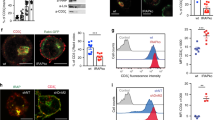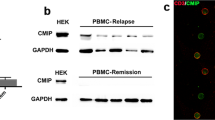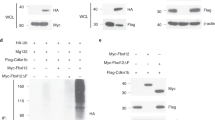Abstract
Lineage choice is of great interest in developmental biology. In the immune system, the αβ and γδ lineages of T lymphocytes diverge during the course of the β-, γ- and δ-chain rearrangement of T-cell receptor (TCR) genes that takes place within the same precursor cell and which results in the formation of the γδTCR or pre-TCR proteins1,2,3. The pre-TCR consists of the TCRβ chain covalently linked to the pre-TCRα protein, which is present in immature but not in mature T cells which instead express the TCRα chain4,5. Animals deficient in pre-TCRα have few αβ lineage cells but an increased number of γδ T cells. These γδ T cells exhibit more extensive TCRβ rearrangement than γδ T cells from wild-type mice6,7. These observations are consistent with the idea that different signals emanating from the γδTCR and pre-TCR instruct lineage commitment8. Here we show, by using confocal microscopy and biochemistry to analyse the initiation of signalling, that the pre-TCR but not the γδTCR colocalizes with the p56lck Src kinase into glycolipid-enriched membrane domains (rafts) apparently without any need for ligation. This results in the phosphorylation of CD3ε and Zap-70 signal transducing molecules. The results indicate clear differences between pre-TCR and γδTCR signalling.
This is a preview of subscription content, access via your institution
Access options
Subscribe to this journal
Receive 51 print issues and online access
$199.00 per year
only $3.90 per issue
Buy this article
- Purchase on Springer Link
- Instant access to full article PDF
Prices may be subject to local taxes which are calculated during checkout




Similar content being viewed by others
References
von Boehmer, H. & Fehling, H. J. Structure and function of the pre-T cell receptor. Annu. Rev. Immunol. 15, 433–452 (1997).
Godfrey, D. I., Kennedy, J., Suda, T. & Zlotnik, A. A developmental pathway involving four phenotypically and functionally distinct subsets of CD3-CD4-CD8-triple negative adult mouse thymocytes defined by CD44 and CD25 expression. J. Immunol. 150, 4244–4252 (1993).
Rodewald, H. R. et al. FcγRII/III and CD2 expression mark distinct subpopulations of immature CD4-8- murine thymocytes: In vivo developmental kinetics and T cell receptor β chain rearrangement status. J. Exp. Med. 177, 1079–1092 (1992).
Groettrup, M. et al. A novel disulfide-linked heterodimer on pre-T cells consists of the T cell receptor β chain and a 33 kd glycoprotein. Cell 75, 283–294 (1993).
Saint-Ruf, C. et al. Analysis and expression of a cloned pre-T cell receptor gene. Science 266, 1208—1212 (1994).
Fehling, H. J., Krotkova, A., Saint-Ruf, C. & von Boehmer, H. Crucial role of the pre-T-cell receptor α gene in development of αβ but not γδ T cells. Nature 375, 795–798 (1995).
Aifantis, I. et al. On the role of the pre-T cell receptor in αβ versus γδ lineage commitment. Immunity 9, 649–655 (1998).
von Boehmer, H. et al. Crucial function of the pre-T cell receptor (TCR) in TCRβ selection, TCRβ allelic exclusion and αβ versus γδ lineage commitment. Immunol. Rev. 165, 111–119 (1998).
Amirand, C. et al. Three distinct sub-nuclear populations of HMG-I protein of different properties revealed by co-localization image analysis. J. Cell Sci. 111, 3551–3561 (1998).
Janes, P. W., Ley, S. C. & Magee, A. I. Aggregation of lipid rafts accompanies signaling via the T cell antigen receptor. J. Cell Biol. 147, 447–461 (1999).
Xavier, R., Brennan, T., Li, Q., McCormack, C. & Seed, B. Membrane compartmentation is required for efficient T cell activation. Immunity 8, 723–732 (1998).
Montixi, C. et al. Engagement of T cell receptor triggers its recruitment to low-density detergent-insoluble membrane domains. EMBO J. 17, 5334–5348 (1998).
Simons, K. & Ikonen, E. Functional rafts in cell membranes. Nature 387, 569–572 (1997).
Harder, T., Scheiffele, P., Verkade, P. & Simons, K. Lipid domain structure of the plasma membrane revealed by patching of membrane components. J. Cell Biol. 141, 929–942 (1998).
Brown, D. A. & Rose, J. K. Sorting of GPI-anchored proteins to glycolipid-enriched membrane subdomains during transport to the apical cell surface. Cell 68, 533–544 (1992).
Shenoy-Scaria, A. M., Dietzen, D. J., Kwong, J., Link, D. C. & Lublin, D. M. Cysteine 3 of Src family protein tyrosine kinase determines palmitoylation and localization in caveolae. J. Cell Biol. 126, 353–363 (1994).
Rodgers, W., Crise, B. & Rose, J. K. Signals determining protein tyrosine kinase and glycosyl-phosphatidylinositol-anchored protein targeting to a glycolipid-enriched membrane fraction. Mol. Cell. Biol. 14, 5384–5391 (1994).
Zhang, W., Trible, R. P. & Samelson, L. E. LAT palmitoylation: its essential role in membrane microdomain targeting and tyrosine phosphorylation during T cell activation. Immunity 9, 239–246 (1998).
Sheets, E. D., Holowka, D. & Baird, B. Critical role for cholesterol in Lyn-mediated tyrosine phosphorylation of FcεRI and their association with detergent-resistant membranes. J. Cell Biol. 145, 877–887 (1999).
Anderson, S. J. & Perlmutter, R. M. A signaling pathway governing early thymocyte maturation. Immunol. Today 16, 99–105 (1995).
Monks, C. R., Freiberg, B. A., Kupfer, H., Sciaky, N. & Kupfer, A. Three-dimensional segregation of supramolecular activation clusters in T cells. Nature 395, 82–86 (1998).
Brown, D. A. & London, E. Functions of lipid rafts in biological membranes. Annu. Rev. Cell Dev. Biol. 14, 111–136 (1998).
Lanzavecchia, A., Lezzi, G. & Viola, A. From TCR engagement to T cell activation: a kinetic view of T cell behavior. Cell 96, 1–4 (1999).
Del Porto, P., Bruno, L., Mattei, M. G., von Boehmer, H. & Saint-Ruf, C. Cloning and comparative analysis of the human pre-T-cell receptor α-chain gene. Proc. Natl Acad. Sci. USA 92, 12105–12109 (1995).
van Oers, N. S., von Boehmer, H. & Weiss, A. The pre-T cell receptor (TCR) complex is functionally coupled to the TCR-ζ subunit. J. Exp. Med. 182, 1585-1590 (1995).
Wange, R. L., Malek, S. N., Desiderio, S. & Samelson, L. E. Tandem SH2 domains of ZAP-70 bind to T cell antigen receptor ζ and CD3ε from activated Jurkat T cells. J. Biol. Chem. 268, 19797–19801 (1993).
Huby, R. D. J., Iwashima, M., Weiss, A. & Ley, S. C. ZAP-70 protein tyrosine kinase is constitutively targeted to the T cell cortex independently of its SH2 domains. J. Cell Biol. 137, 1639–1649 (1997).
Irving, B. A., Alt, F. W. & Killeen, N. Thymocyte development in the absence of pre-T cell receptor extracellular immunoglobulin domains. Science 280, 905–908 (1998).
Gunning, P., Leavitt, J., Muscat, G., Ng, S. Y. & Kedes, L. A human β-actin expression vector system directs high-level accumulation of antisense transcripts. Proc. Natl Acad. Sci. USA 84, 4831–4835 (1987).
Acknowledgements
We thank C. Amirand for advice in quantitative colocalization analysis; J. Feinberg, C. Garcia and I. Aifantis for help in thymocyte analysis; E. Barbier for advice on biochemistry; P. Pereira for γδTCR transgenic mice; and Y. Goureau for assistance in confocal microscopy. We thank E. D. Smith for help with the artwork and L. Holcomb for preparation of the manuscript. H.v.B. is supported by the Koerber Foundation (Germany). F.G. is a recipient of a Biotech grant from European Community.
Author information
Authors and Affiliations
Corresponding author
Rights and permissions
About this article
Cite this article
Saint-Ruf, C., Panigada, M., Azogui, O. et al. Different initiation of pre-TCR and γδTCR signalling. Nature 406, 524–527 (2000). https://doi.org/10.1038/35020093
Received:
Accepted:
Published:
Issue Date:
DOI: https://doi.org/10.1038/35020093
This article is cited by
-
Transcription factors and target genes of pre-TCR signaling
Cellular and Molecular Life Sciences (2015)
-
Visualization and quantification of monoallelic TCRα gene rearrangement in αβ T cells
Immunology & Cell Biology (2014)
-
The structural basis for autonomous dimerization of the pre-T-cell antigen receptor
Nature (2010)
-
Differential subcellular localization regulates c-Cbl E3 ligase activity upon Notch3 protein in T-cell leukemia
Oncogene (2010)
-
Molecular mechanisms that control mouse and human TCR-αβ and TCR-γδ T cell development
Seminars in Immunopathology (2008)
Comments
By submitting a comment you agree to abide by our Terms and Community Guidelines. If you find something abusive or that does not comply with our terms or guidelines please flag it as inappropriate.



